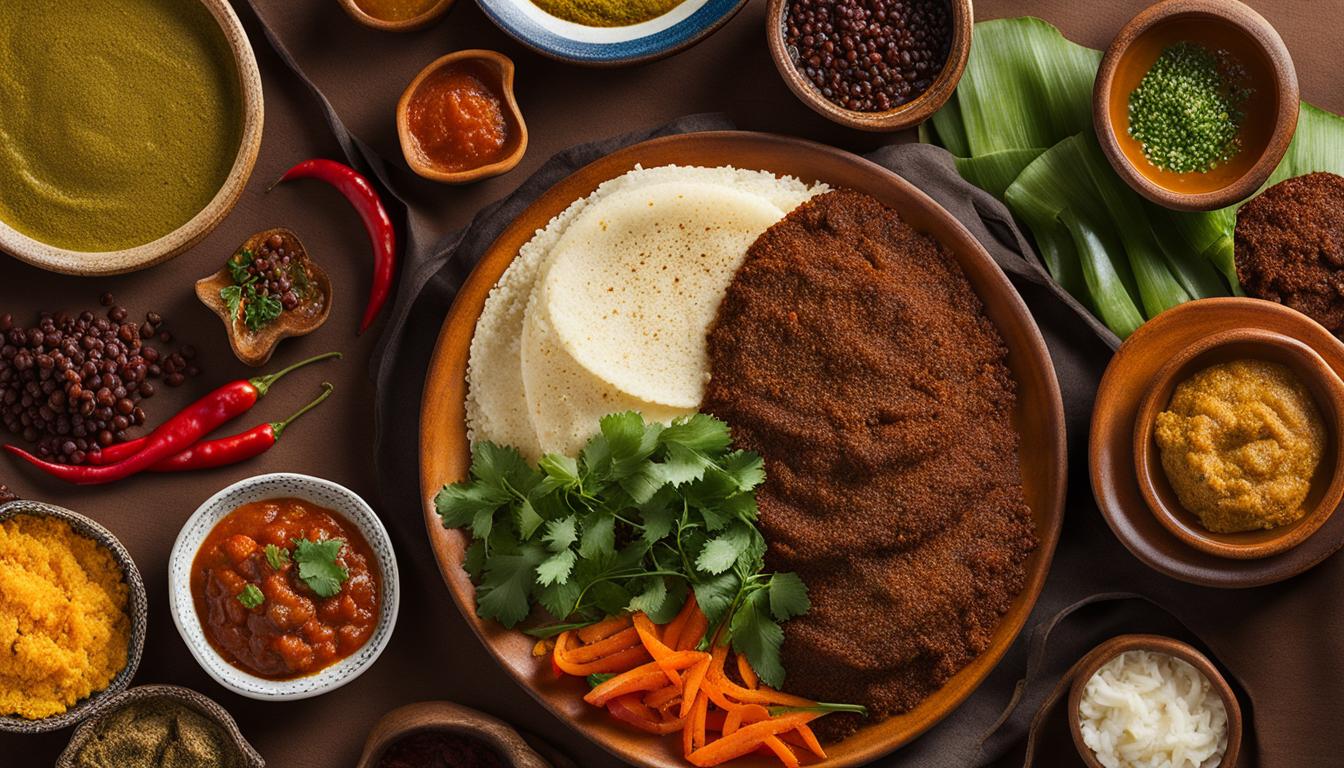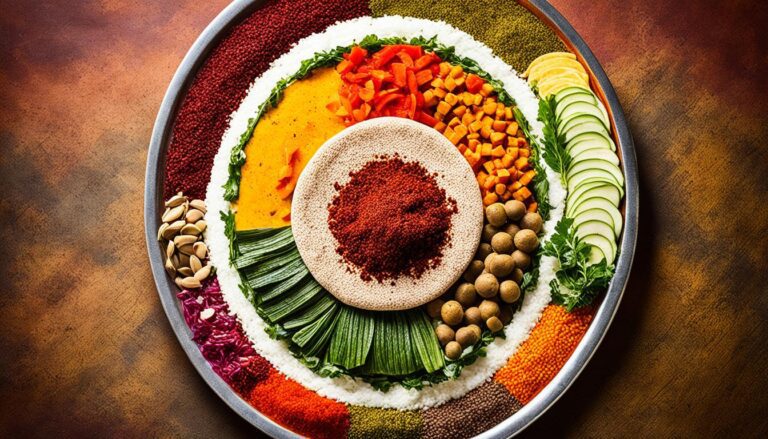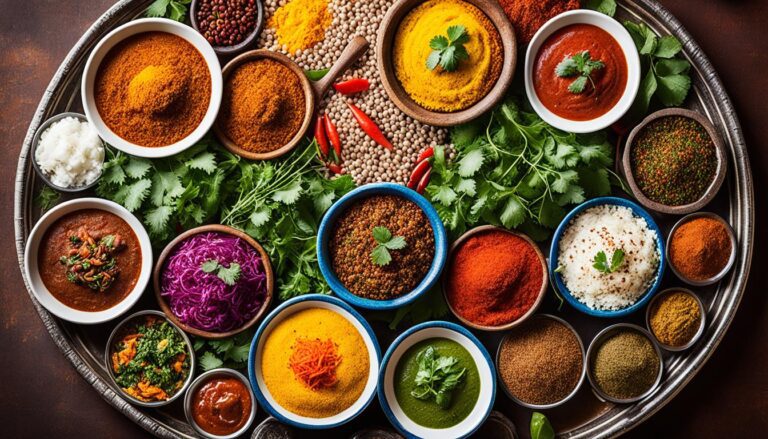Does Ethiopian Food Have Fufu?
Welcome to our exploration of Ethiopian cuisine, where we uncover the tantalizing flavors of this vibrant culinary tradition. Today, we dive deep into the world of Ethiopian food and answer a burning question: Does Ethiopian cuisine incorporate the West African staple, fufu?
When it comes to food, there is always something fascinating to discover. Join us on this culinary journey as we unravel the rich tapestry of Ethiopian flavors and unravel the mystery behind the absence of fufu in Ethiopian cuisine.
Key Takeaways:
- Ethiopian food is renowned for its flavorful and diverse dishes
- Injera, kitfo, and doro wat are just a few examples of traditional Ethiopian delicacies
- Unlike some African cuisines, Ethiopian food does not typically include fufu as a staple dish
- Embrace the unique flavors of Ethiopian cuisine and savor the delicious journey it offers
Introduction to Ethiopian Cuisine
Before we delve into the specific dishes, let’s take a moment to understand the essence of Ethiopian cuisine. Known for its rich flavors and unique spices, Ethiopian food is a reflection of the country’s diverse culture and history.
Ethiopian cuisine offers a captivating blend of traditional dishes that have been passed down through generations. The flavors found in Ethiopian food are a true testament to the country’s diverse landscape, ancient traditions, and vibrant culture.
From the highlands to the lowlands, Ethiopian cuisine incorporates a wide variety of ingredients, resulting in a culinary experience that is both exciting and satisfying. The use of spices, such as berbere and mitmita, adds depth and complexity to the flavors, while the combination of different textures and cooking techniques makes each dish a unique gastronomic delight.
Exploring Traditional Ethiopian Dishes
When it comes to traditional Ethiopian dishes, there is something for everyone. Whether you’re a meat lover, vegetarian, or vegan, Ethiopian cuisine offers a range of options to tantalize your taste buds.
One of the most iconic dishes in Ethiopian cuisine is injera, a sourdough flatbread that serves as the foundation for many meals. Injera is made from teff, a gluten-free grain that adds a distinct nutty flavor to the bread. It is typically served with a variety of stews and curries, allowing diners to enjoy a rich combination of flavors in every bite.
For meat enthusiasts, kitfo is a must-try dish. This seasoned minced raw meat dish is often served with injera and a side of spicy butter, providing a unique and intense flavor profile.
Doro wat, a spicy chicken stew, is another popular dish in Ethiopian cuisine. Made with a rich blend of spices, including berbere, this hearty stew is typically enjoyed with injera or rice, creating a harmonious balance of flavors.
Vegetarians and vegans will also find a plethora of options in Ethiopian cuisine. From flavorful lentil stews, such as misir wat, to aromatic vegetable curries, like atakilt wat, there are numerous plant-based dishes that showcase the diverse flavors of Ethiopian cuisine.
With its diverse array of traditional dishes and bold flavors, Ethiopian cuisine is a hidden gem waiting to be explored. Embark on a culinary journey that will transport you to the vibrant streets of Addis Ababa and beyond, as you savor the authentic tastes of Ethiopia.
Traditional Ethiopian Dishes
Ethiopian cuisine is renowned for its diverse and mouthwatering traditional dishes. Let’s embark on a culinary journey and explore some of the flavorful delights that Ethiopian food has to offer.
Injera: The Spongy and Sour Flatbread
One of the most iconic staples of Ethiopian cuisine is injera. This spongy, sourdough flatbread serves as both a utensil and a base for many dishes. Made from teff flour, injera has a unique texture and tangy flavor that perfectly complements the rich and spicy flavors of Ethiopian dishes.
Kitfo: A Flavorful Minced Meat Dish
For meat lovers, kitfo is a must-try dish. This traditional Ethiopian delicacy consists of finely minced raw meat, seasoned with spices such as mitmita (a chili pepper blend) and niter kibbeh (spiced clarified butter). Served with injera, kitfo offers a bold and savory experience that is sure to tantalize your taste buds.
Doro Wat: Spicy Chicken Stew
No tour of Ethiopian cuisine is complete without indulging in doro wat. This fiery and aromatic chicken stew is cooked with berbere spice blend, which includes chili peppers, ginger, garlic, and a variety of fragrant spices. The result is a rich and complex flavor profile that perfectly captures the essence of Ethiopian cuisine.
Tibs: Flavorful Ethiopian Stir-Fry
Tibs is a popular dish in Ethiopian cuisine, typically prepared with marinated pieces of meat, onions, and aromatic spices. The ingredients are stir-fried to perfection, creating a mouthwatering combination of flavors and textures. Whether it’s beef, lamb, or chicken, tibs is a must-try dish that showcases the skillful art of Ethiopian cooking.
With Injera, kitfo, doro wat, and tibs as just a few examples, Ethiopian cuisine offers a myriad of scrumptious dishes that will take your taste buds on a culinary adventure. From the tangy and sour flavors of injera to the spicy and aromatic profiles of doro wat, each dish is unique and provides a glimpse into Ethiopia’s rich culinary heritage.
Exploring Ethiopian Food Staples
When it comes to Ethiopian cuisine, staple foods play a crucial role in shaping the unique flavors and culinary traditions of the country. While fufu is commonly associated with West African cuisine, Ethiopian food has its own set of staple ingredients that are essential to the rich and vibrant dishes.
Injera is a staple food in Ethiopian cuisine that holds a special place in the hearts of locals. This sourdough flatbread is not only a versatile accompaniment to various dishes but also serves as the foundation of many Ethiopian meals. Made from fermented teff flour, injera has a tangy taste and a unique spongy texture that perfectly complements the bold flavors of Ethiopian stews and curries.
One popular Ethiopian dish that showcases the versatility of injera is doro wat, a spicy chicken stew. Served on top of a large piece of injera, doro wat combines tender chicken, flavorful spice blends, and a rich sauce made from tomatoes, onions, and aromatic Ethiopian spices. The injera soaks up the flavors of the stew, creating a truly sensational dining experience.
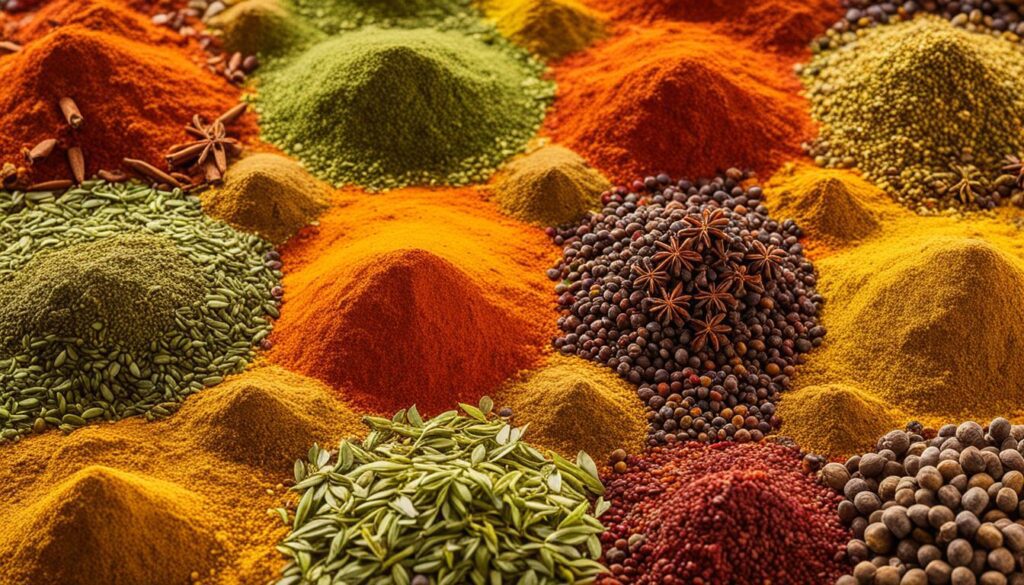
The use of traditional Ethiopian spices is also a defining characteristic of the cuisine, adding depth and complexity to the flavors. These spices, such as berbere and mitmita, are expertly blended combinations of herbs, spices, and chilies that create a harmonious balance of heat, sweetness, and earthiness in Ethiopian dishes.
Exploring the staple foods of Ethiopian cuisine, such as injera, doro wat, and the unique spice blends, offers a delightful journey into the heart of Ethiopian flavors and culture. The combination of these staple ingredients creates a truly distinct and memorable culinary experience that is a testament to the rich gastronomic heritage of Ethiopia.
Absence of Fufu in Ethiopian Food
In the rich tapestry of African cuisines, fufu has long been associated with West African culinary traditions, serving as a staple dish in countries like Nigeria and Ghana. However, when it comes to Ethiopian food, fufu is notably absent from the traditional repertoire.
Ethiopian cuisine is renowned for its distinctive flavors and ingredients, showcasing a fusion of spices and techniques that create a culinary experience like no other. In place of fufu, Ethiopian food features a diverse array of dishes that highlight the country’s cultural heritage and gastronomic flair.
One of the key elements of Ethiopian cuisine is injera, a spongy and sourdough flatbread that plays a central role in the dining experience. Injera serves as a communal base, accompanying various stews, curries, and sautéed dishes known as tibs.
While fufu is typically made from pounded starchy ingredients like yam, cassava, or plantain, Ethiopian cuisine showcases different staple foods. These include hearty stews like doro wat, a spicy chicken dish simmered in a rich berbere sauce, and kitfo, a minced raw meat delicacy seasoned with spices and herbs.
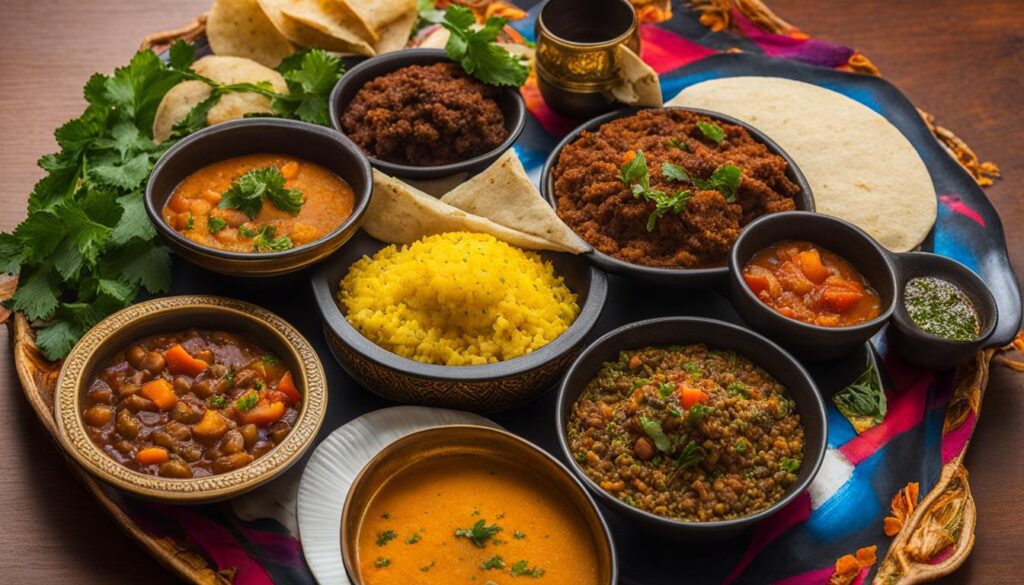
Ethiopian food is also characterized by its vibrant use of spices. Berbere, a fiery red spice blend, adds depth and complexity to many dishes, infusing them with its distinctively aromatic and warming flavors. Other commonly used spices in Ethiopian cooking include nigella, fenugreek, and cardamom, which contribute to the unique taste profiles of the cuisine.
So, while fufu may not be found in Ethiopian food, exploring the country’s rich and diverse culinary traditions is a rewarding journey in its own right. From the complexity of flavors to the communal dining experience, Ethiopian cuisine offers a truly unique taste of Africa.
Conclusion
In conclusion, Ethiopian cuisine is a treasure trove of flavors and culinary traditions. While fufu is not a traditional dish in Ethiopian food, this vibrant cuisine offers a diverse array of dishes that will take your taste buds on a delightful journey.
From the iconic injera, a sourdough flatbread that serves as the foundation for many Ethiopian meals, to the bold and spicy doro wat, a chicken stew bursting with aromatic Ethiopian spices, each bite offers a glimpse into the rich cultural heritage of the country.
If you’re looking to explore the wonders of Ethiopian cuisine, be prepared to experience a symphony of flavors and textures. Whether you’re a fan of vegetarian dishes like the fragrant and hearty misir wat or the adventurous carnivore who savors the raw meat delicacy kitfo, Ethiopian cuisine has something to offer everyone.
So, if you’re craving a culinary adventure and want to immerse yourself in the world of Ethiopian food, give it a try. You’ll discover a melting pot of flavors that will transport you to the vibrant streets and bustling markets of Ethiopia, all without a trace of fufu in sight.

